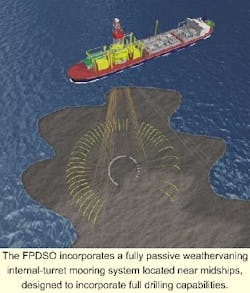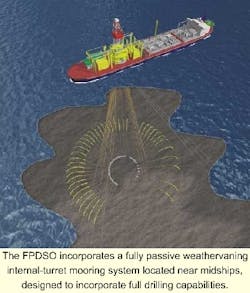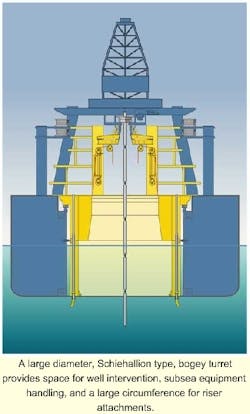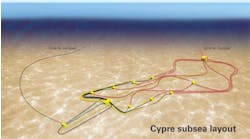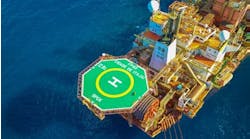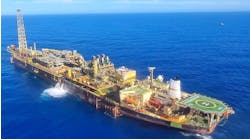FLOATING PRODUCTION: Why drilling space comes at least cost on floating production vessels
L. Poldervaart
Single Buoy Moorings Inc.
J. Lusthof
Gusto Engineering
Drilling from moored monohulls (floating drilling barges) took place many years before jackup and semisubmersible drilling platforms were invented. As activities moved into deeper water and more exposed locations, more refined drillships were developed. Some of the designs included mooring turrets and weathervaning capability. In the early 1970s, 100% dynamically positioned (DP) units were introduced.
Drillships are now widely used in many parts of the world. They have excellent performance characteristics for most regions and are very competitive because of the high degree of self-supporting ability (storage capacity or payload). In Brazil, more than 200 wells have been drilled from DP drillships.
Floating production, storage, and offloading (FPSO) vessels are used worldwide and are operating in benign as well as in harsh environments of the Norwegian Sea and the West of Shetlands. An important feature of the FPSO is the oil storage capacity it offers.
Experience has shown that large storage capacity improves the regularity of the total production system (including offloading) and now is a "driver" for sizing. In other words, the topsides will not require all the available deck space, thus offering space for other duties (drilling) that is virtually free of charge. Hence, the merits of drilling from a large hull can be obtained at a moderate cost contribution from the "carrier" - the FPSO.
The incentive for drilling onboard the FPSO has become more apparent as exploration activities move into deeper and more remote areas. The main reason is the low number of suitable mbile offshore drilling units (MODUs). Several rig newbuilds are underway, but the new rigs will hardly compensate for the increase in planned exploration and development in deepwater. As a consequence, rig rates have reached record levels. In addition, development drilling and well maintenance operations are a major cost contributor to deepwater field development. Even light well service operations in these water depths are dependent on similar units, as the industry so far has not invested to find reliable methods and vessels for these deepwater operations.
A simple cost comparison of total capital and operating costs can be easily demonstrated. Under certain conditions, incorporating workover or drilling equipment onboard the FPSO will provide a substantial decrease in the breakeven oil price of a field development. Experience has also shown that availability of a rig for well workover often leads to more frequent use and consequently results in added recoverables, an effect too often neglected during concept comparison. Such conditions would typically imply:
- Reservoir drainage from mainly one location
- No pipeline, so storage is needed
- Deep water.
These conditions are quite common when looking at the acreage being developed in many parts of the world. Typically one might find this situation in Brazil, Norwegian Sea, West of Shetlands, and other areas. Combining these concepts results in the development of a floating production, drilling, storage, and offloading (FPDSO) unit, jointly developed by Single Buoy Moorings Inc., Kværner Oil and Gas, and Gusto Engineering. The unit has been designed as a stand-alone, having the capability to carry out full field development and operations on subsea trees in deepwater fields off Brazil, with specific functional requirements provided by Petrobras.
All of the advantages of an FPSO are incorporated with a fully passive weathervaning internal-turret mooring system located near midships. This midship turret has been designed to incorporate full drilling capabilities. Thrusters, which offer heading control, provide the same high drilling availability achieved by drillships.
The large vessel deck also provides traditional FPSO safety with horizontal separation of the drilling and topsides functions. Estimates have shown that savings by workover or drilling from the FPDSO provides significant per-barrel produced oil savings, compared to a traditional development based on a separate hired workover or drilling unit.
Concept description
The FPSO unit consists of a free weathervaning mono-hull vessel, passively moored to the seabed by a number of anchor lines connected to a turret-type mooring system inside the vessel. The vessel could be either a newbuild vessel or a converted tanker.
Live crude is received via subsea lines and a flexible riser system from subsea wells drilled in fields near the FPSO by a separate drilling unit. On the turret manifold deck, the oil streams are collected, and the crude is received on board via product swivels located on top of the manifold room. Thereafter, the crude passes through the process facilities for separating oil, water, and gas, before flowing to storage.
Produced water is treated and dumped overboard. Produced gas is treated and disposed of. Some of the gas will fire the gas turbine generators, while the remainder is re-injected or exported. The oil cargo is periodically discharged into tandem moored shuttle tankers. On board the FPSO, all functions are monitored and controlled from a permanently manned control room located in the accommodation block.
Well intervention FPSO
The floating production, well intervention, storage, and offloading (FPWSO) unit is based on an FPSO with well intervention equipment. The unit provides for production while wells within reach of the unit can be maintained. The unit facility is expected to be an attractive solution for smaller, remote deepwater fields with high well maintenance requirements.
The FPWSO was specifically developed with both well intervention and production requirements fully integrated into the vessel, without compromising or sacrificing the safety, availability, and operability of either function. Subsea wells are assumed to be equipped with a subsea well intervention blowout preventer (SWIB) to avoid blowout preventer (BOP) or christmas tree handling. Well intervention operations are limited to riserless operations (light well intervention).
The workover arrangement is based on a novel solution for workover through the center of the geostationary large diameter turret unit. Placing the workover support structure over and around the turret created a traditional drilling vessel operation without affecting the turret loading. The key features of the FPWSO for field development are:
- Simultaneous production and well maintenance - wells are predrilled and completed from a MODU during a FPWSO conversion or new build. The unit can start production as soon as installed.
- The ability to tie-in up to 75 risers using a conventional tie-in and tensioning arrangement makes well intervention achievable.
Well intervention involves:
- Logging and coring operations
- Well testing and reservoir stimulations
- Tubing replacement
- High availability due to low overall vessel motions (optimized turret location)
- Large deck area for equipment lay down and storage
Layout of the well intervention involves:
- Safety principles based on "safety by distances"
- Traditional topsides layout
- All well service equipment located above the turret and swivel, and separated from topsides functions and fluid transfer.
Construction of the well intervention FPSO involves a combination of the FPSO and well intervention equipment, easily fabricated by most shipyards. Offshore installation is similar to that of FPSOs, provided that all wells are pre-drilled from a MODU by the time of the offshore installation. In terms of operations and maintenance, the FPWSO stationkeeping system is passive and does not require thruster assistance. The stand-alone FPWSO system consists of the following components, which have been integrated into a single unit:
- ULCC tanker size: Various tankers are available that are suited for conversion into a FPWSO with respect to size, condition, and availability. Alternatively, a newbuild vessel could be used. With large payload and space available, tankers can easily cater for large topsides and area for well intervention facilities in stand-alone deepwater developments.
- Stationkeeping system: Stationkeeping is a fully passive internal turret mooring system using synthetic ropes. The turret location will be optimized to achieve both static and dynamic stability and favorable vessel motions for well intervention.
- Heading control: Although not required for stationkeeping, heading control uses two azimuth thrusters to improve the vessel roll response and provides positioning control of the FPWSO for maneuvering over wellheads and during tandem offloading.
- Turret and fluid transfer: A large diameter, Schiehallion type, bogey turret provides space for well intervention, subsea equipment handling, and a large circumference for riser attachments. The risers are configured inside a double wall at the periphery of the turret moonpool. This allows free unobstructed access for well intervention activities. The fluids are transferred from the risers to the topsides via a manifold room and a large diameter swivel stack with clearance through its center for the workover string.
- Well intervention: The unit can be equipped with any light well intervention derrick. During well intervention, the unit is located vertically above the wells by adjusting the mooring line lengths with individual tensioning winches.
- Process facilities: The topside process facilities are based on 150,000-b/d production.
- Offloading facilities: The FPWSO will be offloaded by a tandem system at the stern.
- Safety: The design specifically considers the safety aspects of the additional well intervention functions in conjunction with production, providing suitable layouts and access and escape for personnel. In particular, the vessel layout provides segregation of well intervention and production facilities and allows for escape of personnel to the bow in case access to accommodation is cut.
Full-scale facilities
The floating production, drilling, storage, and offloading (FPDSO) unit is based on an FPSO with full well drilling, completion, and well workover equipment. The unit provides for production while drilling where wells within reach of the unit will be drilled and maintained directly from the FPDSO, and the balance from a separate MODU. The FPDSO facility is expected to be an attractive solution for larger remote deepwater fields with high drilling and well maintenance requirements.
The FPDSO was specifically developed with both drilling and production requirements fully integrated into the vessel without compromising or sacrificing the safety, availability, and operability of either function. The design focused on achieving operational flexibility, low technical risk, cost, using proven designs, and standard industry equipment. For field development, the unit incorporates:
- Simultaneous production while drilling, where wells are predrilled from the MODU during FPDSO conversion, and production begins as soon as wells are completed.
- The ability to tie-in up to 75 risers (including umbilicals) using a conventional tie-in and tensioning arrangement.
- A production process, such as an electrical submersible pump (ESP) system, can be incorporated as an alternative to gas lift.
The drilling functions includes:
- Drilling capacity is comparable to MODUs.
- Deepwater drilling due with low overall vessel motion is achieved by optimizing turret location and vessel thruster assistance for heading control.
- A large diameter moonpool (22 meters) for drilling and subsea equipment handling.
- A large deck area for drilling equipment lay down, storage, and pipe handling.
The stand-alone FPDSO system comprises the following major components:
- ULCC tanker: Like the FPWSO, the unit incorporates the BOP, drilling riser, and drillpipe storage and handling systems equivalent to standard drillships.
- Stationkeeping, heading control: Similar to that of the FPWSO.
- Turret/fluid transfer: As with an FPWSO, some utilities are transferred via a double drag chain system to reduce the height of the swivel stack and drill floor.
- Drilling: The FPDSO can be equipped with any drilling derrick. While drilling or working over, the FPDSO is located vertically above the wells by adjusting the mooring line lengths with individual mooring line-tensioning winches.
- Process, offloading, safety: Similar to the FPWSO
Field development
Brazil's oil fields are heavy oil reservoirs of 200-500 million bbl recoverable, located at a true vertical depth (TVD) of 3,000 meters in 1,000 meters water depth. Crude density there is 21
- The use of a stand-alone, turret-moored FPSO, FPWSO, or FPDSO with drilling, production, crude storage, and tandem export facilities.
- Several production and water injectors, tied back individually to the production unit, or a combination of horizontal, vertical, and deviated subsea-completed wells.
- The reservoirs are within reach of the FPWSO or FPDSO (less than 4,000 meters horizontal offset) and can be drilled or maintained directly from the unit.
- The remaining wells further away can be drilled and subsea-completed from a separate MODU. Some of these producers may be pre-drilled to allow immediate tie-back and first production after the installation of the FPWSO or FPDSO.
- The FPWSO or FPDSO unit will then operate with simultaneous production while drilling/workover.
- The well producers will also be able to accept gas lift later on in the field life.
- Produced gas will be exported by pipeline.
The well casing program is expected to consist of the following design for production (and any subsequent gas injection) wells:
- 36-in. casing set at 50 meters TVD below seabed
- 20-in. casing set at 250 meters TVD below seabed
- 13 3/8-in. casing set at 2,000 meters TVD below seabed
- 9 5/8-in. casing set at 3,000 meters TVD below seabed
- 7-in. liner set at 3,000 meters TVD below seabed.
The vessel and mooring system is designed for a service life of 20 years. Also, the 100-year return storm conditions for the Campos Basin region are assumed for the design environmental conditions of the vessel.
Field data
The subsea wells are arranged in a circular horseshoe configuration with a radius of approximately 50-100 meters from the center axis of the drill/workover string with the FPDSO located in its nominal position. The distance between the wells will be sufficient for BOP and tree installation and tie-in of risers. Also, by adjusting the mooring chain, the moonpool can still be relocated above any well, including the drift of the drilling riser due to the one-year current.
Pigging facilities will be available between the subsea wells and the FPSO, FPWSO, or FPDSO by using the gas lift service line and the production riser line. The FPSO, FPWSO, or FPDSO will have the following process plant capacity for the 150,000 b/d case:
- 150,000 b/d of oil
- 100,000 b/d produced water
- 4¥1, 500,000 cu m/d (spare included) of gas capacity
- Gas export dew point target - 15
The other cases are proportionally reduced, a product of the process plant capacity. Safe accommodation should house 60 people for the FPSO, 100 for the FPWSO, and 200 for the FPDSO. The drilling or workover facilities should meet the drilling program requirements as specified.
Risk discussion
There may be considerable reluctance among field developers to bring the workover or drilling onboard an FPSO. However, drilling from a deepwater drillship, plus separately producing, storing, and exporting oil from a conventional FPSO, are technically, operationally, and economically well proven.
The FPDSO design was subject to a safety evaluation incorporating a course risk quantification safety review sessions with potential clients, an outside safety specialist consultant, operators, and other factors. The sessions identified hazards with focus on special safety aspects related to the overall FPDSO design.
No general evidence indicates workover or drilling from production units offshore leads to non-acceptance risk levels. There are thousands of rig years of experience in operating such units in all regions of the world. This includes a number of condeep types, jackets with oil storage in the legs. Even the semis for Njord and Visund have successfully operated with combined functions of drilling and production. Hence, one cannot argue against the FPWSO and FPDSO concept on a general basis.
- Both the FPWSO and FPDSO concepts are based on the well-proven designs of the FPSO and the drillship with standard drilling equipment.
- From the case studies presented, the FPWSO and the FPDSO are both concepts of interest for all cases studied with a lower breakeven oil price compared to the FPSO.
- The FPWSO is particularly attractive when the drilling period does not exceed the vessel construction or conversion period (smaller fields). The main reason is that the first oil production date comes later in the case of the larger fields; therefore, an early cash recovery is not achieved. For the smaller fields, the FPWSO becomes very attractive.
- The FPDSO is attractive for all scenarios analyzed, and savings up to $1/bbl can be achieved for a large field, compared to a standard field development scenario using an FPSO with a separate subsea center. In case the specified fields require a larger number of production wells for the same production rate, the FPDSO becomes even more attractive.
- The procurement, fabrication and integration of drilling or workover components should not significantly affect a project schedule, compared to a conventional FPSO.
